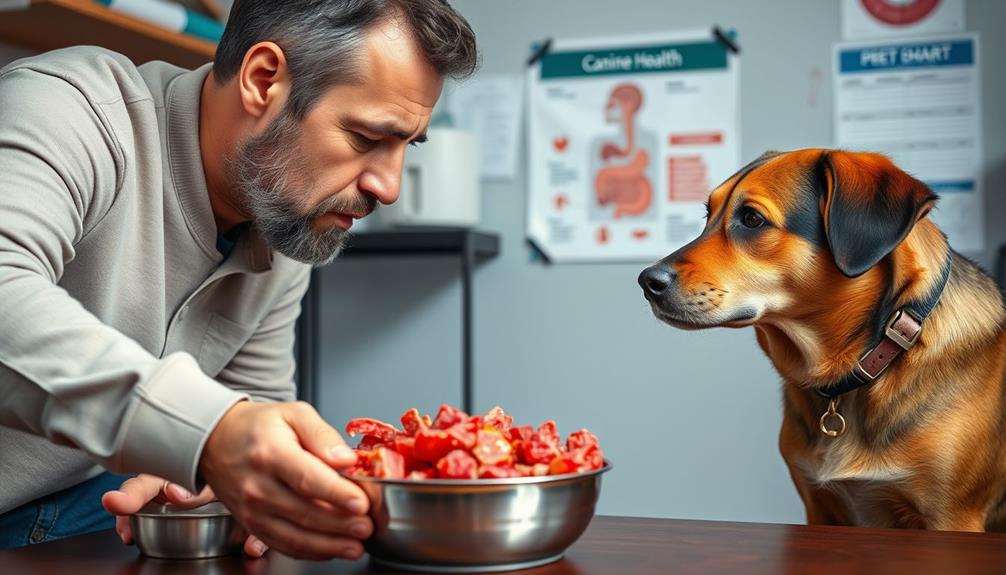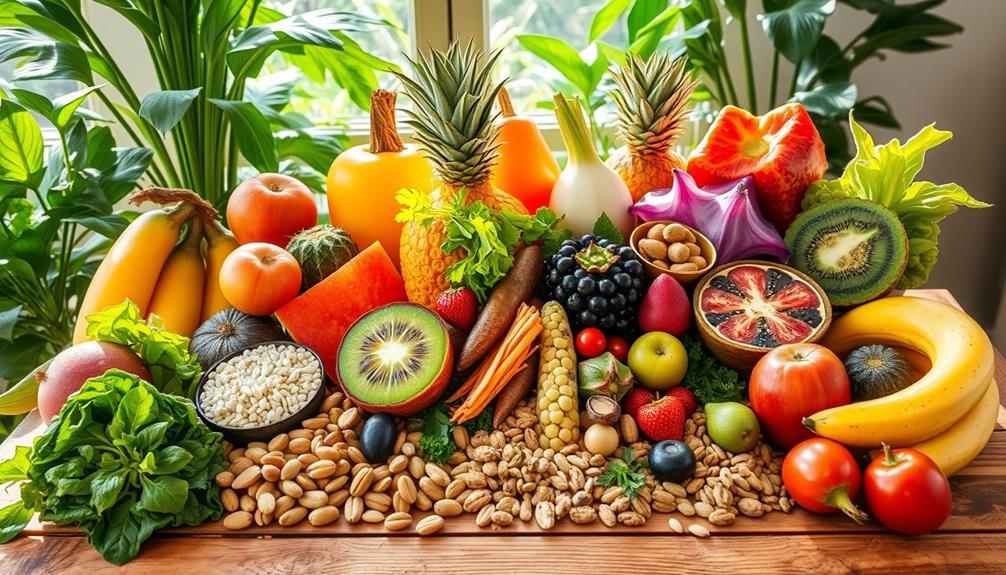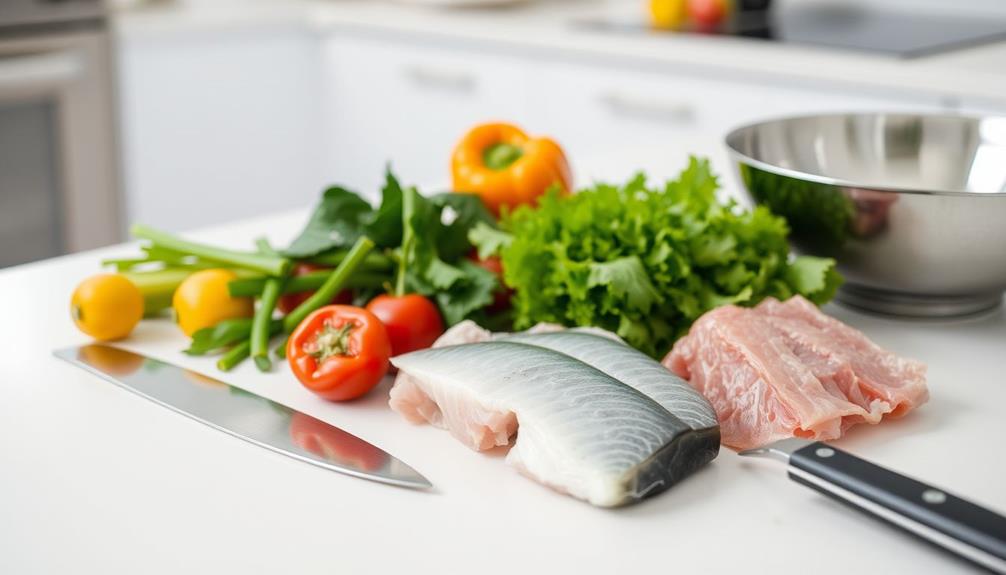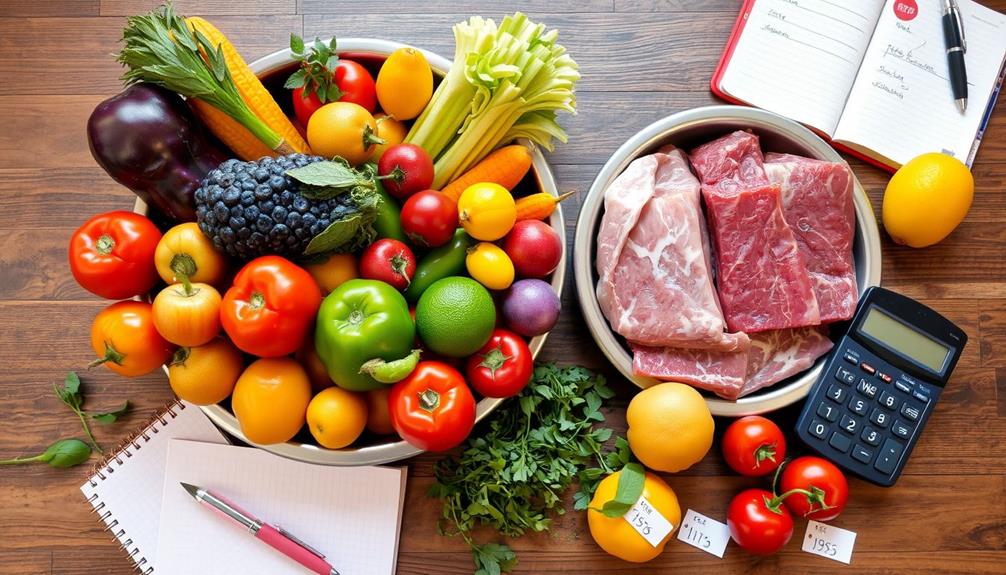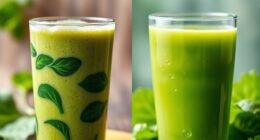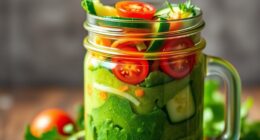Raw food can cause diarrhea in dogs, especially during the adjustment period. When you switch your dog's diet abruptly, their digestive system might struggle to adapt, leading to loose stools or increased bowel movements. To prevent this, gradually introduce raw food over 7-10 days. Start with a mix of 75% old food and 25% raw, and adjust as needed based on your dog's response. Keep an eye on their stool consistency throughout the adjustment. If diarrhea persists, consider consulting your vet for tailored dietary advice. There's a lot more to explore about keeping your dog healthy on a raw diet.
Key Takeaways
- Transitioning to raw diets should be gradual over 7-10 days to minimize the risk of diarrhea and digestive upset.
- Abrupt dietary changes can cause loose stools and diarrhea within 6-12 hours due to digestive disruptions.
- High-fat raw diets and improper bone-to-meat ratios may lead to gastrointestinal disturbances and diarrhea.
- Mixing different protein sources can overwhelm the digestive system, leading to digestive issues like diarrhea.
- Regular monitoring of stool consistency during the transition is essential to identify and address potential problems promptly.
Understanding Raw Food Diets
When it comes to your dog's diet, you might be curious about the growing trend of raw meat-based diets (RMBDs). Many pet owners are now feeding their dogs some form of a raw food diet, with estimates showing that 15-25% of dogs are on this regimen.
RMBDs align with the ancestral eating habits of dogs, providing higher levels of antioxidants compared to conventional processed diets. It's crucial to highlight that just like humans, dogs can experience dietary changes that may require careful management, especially regarding financial considerations for elderly care if the shift involves specialized meals or consultations.
If you're considering moving to raw, it's vital to do so gradually, usually over 7-10 days. This slow introduction helps your dog's digestive system adapt, reducing the chances of digestive upset. You might notice softer stools at first, which is common during this change.
One notable ingredient in many raw diets is green tripe, known for its natural probiotics that support gut health and overall well-being.
While many dog owners report healthier body conditions and improved energy levels after switching to raw, ongoing research is still needed to fully understand the long-term health impacts.
Common Digestive Issues

Switching to a raw food diet can lead to some common digestive issues that pet owners should be aware of. During the adjustment period, it's not uncommon for your dog to experience loose stools and increased bowel movement frequency, especially within the first 7-10 days as their digestive system adjusts.
This adjustment can sometimes result in digestive upset, particularly if the raw diet is high in fat or lacks balance with other nutrients. Additionally, proper diet management is essential for your dog's health, as highlighted in our Ultimate Hamster Care Guide, emphasizing the importance of balanced nutrition.
Mixing different protein sources in your dog's meals can complicate digestion, potentially resulting in gastrointestinal issues like diarrhea.
Additionally, some dogs may have food intolerances or allergies that only become apparent after introducing raw diets, so it's important to monitor any changes closely.
Don't overlook the importance of safe meat handling practices, either. Contaminated food sources can lead to gastrointestinal upset due to pathogens, which can further exacerbate your dog's digestive issues.
Transitioning to Raw Diets
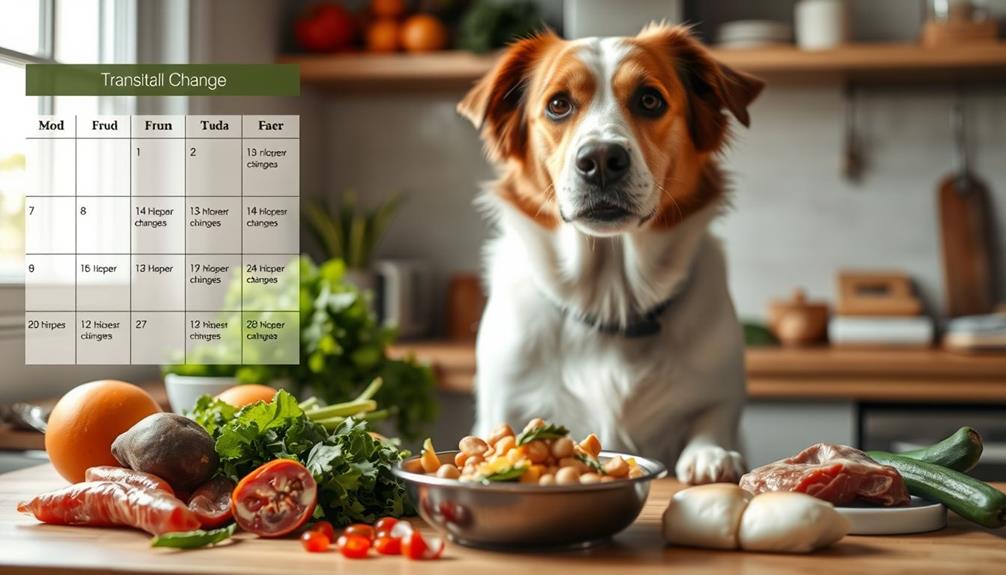
Shifting your dog to a raw diet can be a rewarding journey, but it requires careful planning to guarantee a smooth adaptation. A gradual shift over 7-10 days is recommended. Start with 75% old food and 25% new food to minimize digestive issues.
| Day | Old Food Portion | New Food Portion |
|---|---|---|
| 1-2 | 75% | 25% |
| 3-4 | 50% | 50% |
| 5-6 | 25% | 75% |
| 7-10 | 0% | 100% |
| Post Shift | Monitor response | Adjust if needed |
During this shift, it's normal for your dog to have softer stools and more frequent bowel movements as their digestive system adjusts. Pay attention to your dog's response and stool consistency throughout this period. If digestive issues persist, consider slowing down the shift process or adjusting the food ratios. Adding green tripe can also help support gut health. Remember, monitoring your dog's response is essential for a successful adaptation to their new diet.
Factors Contributing to Diarrhea
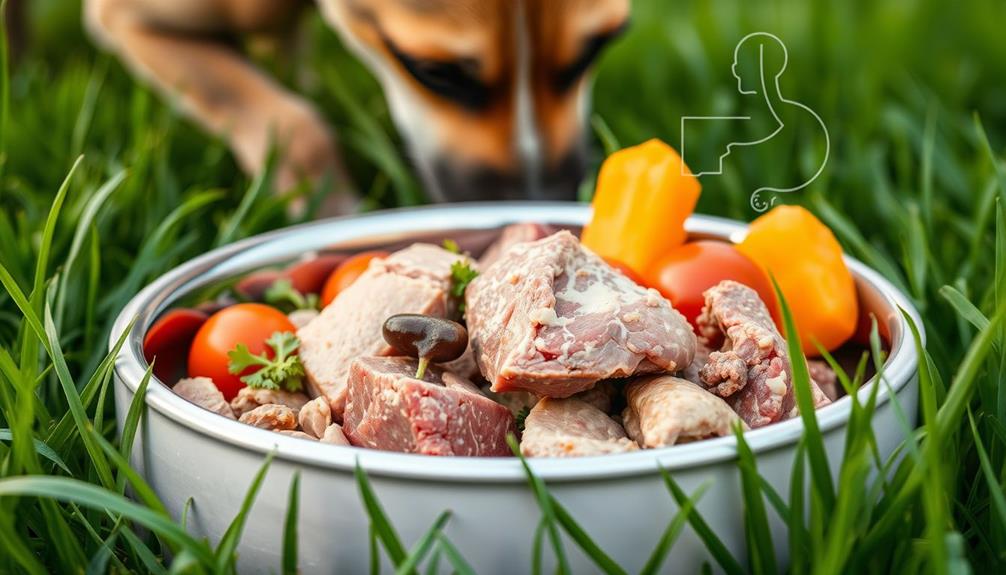
When you shift your dog to a raw diet, you might notice some digestive upset, including diarrhea.
It's vital to take into account how different protein sources interact and whether your dog has enough digestive enzymes to handle the new food.
Cold medications overview may not be directly related, but understanding how dietary changes can affect your dog's health is essential.
These factors can greatly affect your dog's gastrointestinal health and overall well-being.
Dietary Transition Impact
Shifting a dog to a raw food diet can often lead to digestive upset, with diarrhea being a common issue. The dietary change impact can be significant, especially if you make abrupt changes. Typically, diarrhea shows up 6-12 hours after the shift.
Raw dog food can sometimes have a high-fat content, which might trigger gastrointestinal disturbances, exacerbating the risk of diarrhea. To guarantee your dog's overall health, it's vital to monitor their response to dietary changes and consider effective strategies for weight loss if necessary. It’s important to note that while raw dog food can provide numerous health benefits, it can also present risks if not properly monitored. In some cases, a sudden switch to raw food or a diet with excessively high fat content can lead to digestive issues such as diarrhea. If you notice symptoms of gastrointestinal distress in your dog, it’s important to consult with a veterinarian to determine the appropriate course of action. Can raw food cause diarrhea? Yes, it is a potential risk, but with careful monitoring and adjustments, it can be minimized to ensure your dog’s well-being.
When you mix different protein sources during the change, it complicates digestion. Each protein has a different digestibility rate, and this can lead to additional health problems, including diarrhea. Additionally, some dogs may have food intolerances or allergies that arise during this period, requiring close monitoring of how they react to new ingredients.
To minimize the risk of digestive upset, it's best to make gradual dietary changes over 10-14 days. This allows your dog's system to adapt properly to the raw diet and reduces the chances of diarrhea.
Protein Source Compatibility
Steering through the complexities of protein source compatibility is essential for maintaining your dog's digestive health on a raw food diet. Various factors can contribute to diarrhea, and understanding them can help you avoid potential pitfalls. Here are four key considerations:
1. Mixing Protein Sources: Combining different protein sources can complicate digestion, leading to diarrhea due to variations in fat content and digestibility.
It's important to remember that diversification strategy in diet can also play a vital role in your dog's health.
2. High-Fat Content: Some meats have high-fat content, which can upset your dog's stomach, especially if they aren't used to such rich foods.
3. Bone-Meat Imbalance: An improper ratio of bone to meat can cause gastrointestinal issues.
Too much bone can lead to constipation, while too much meat can result in diarrhea.
4. Food Allergies: If your dog has food allergies or intolerances to specific protein sources, sudden changes in their diet can trigger digestive disturbances.
To maintain a balanced raw diet, introduce new proteins gradually. This approach minimizes the risk of overwhelming your dog's digestive system and helps prevent diarrhea.
Digestive Enzyme Deficiency
Digestive enzyme deficiencies can be a significant hurdle for dogs shifting to a raw food diet. When you switch your dog from kibble to raw, their digestive system might struggle, especially if they weren't getting enough enzymes before. Enzymes like amylase, protease, and lipase are vital for breaking down carbohydrates, proteins, and fats. Without adequate levels, your dog may experience gastrointestinal upset, leading to diarrhea.
Additionally, a diet rich in antioxidants and vitamins can support overall health, which may help during this change.
If your furry friend has pre-existing digestive issues, they may be even more vulnerable to these problems during the change. The sudden dietary shift can overwhelm their system, making it harder to digest the new food properly.
To support your dog's digestive health, consider supplementing their diet with natural digestive aids like enzyme powders or probiotics. These can help bridge the gap and promote better digestion.
Monitoring your dog's response during this change is important. If you notice signs of distress, it might be worth consulting your vet for advice tailored to your dog's specific needs.
Prevention and Management
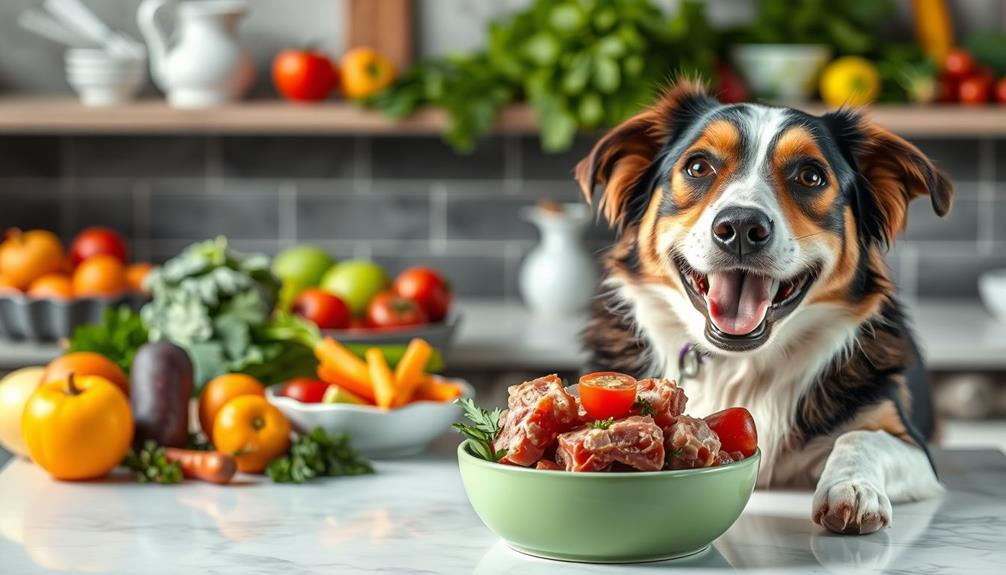
To keep your dog healthy while shifting to a raw food diet, you should gradually adjust their meals over 7-10 days.
This gradual approach can help prevent issues similar to those seen in newborn bowel movement frequency, where sudden changes may lead to digestive discomfort.
Focus on a balanced nutrient composition to avoid digestive issues, and don't forget to monitor their stool consistency closely.
If you notice any persistent problems, it's important to consult your vet for guidance.
Gradual Diet Transition
Shifting your dog to a raw food diet requires careful planning to minimize any potential digestive upset. A gradual diet change is key to helping your dog's digestive system adapt smoothly. Incorporating healthy dog snacks can also help ease the change while providing natural ingredients that promote overall health.
Here's a simple approach to follow:
- Day 1-2: Start with 75% old food and 25% raw food.
- Days 3-5: Increase the raw food ratio to 50%, while keeping the same protein source.
- Days 6-7: Move to 75% raw food and 25% old food.
- Day 8 onward: Change fully to raw food, monitoring for any signs of digestive issues.
During this change, it's normal for your dog to have softer stools and more frequent bowel movements. Keep an eye on their condition—if runny stools persist beyond 7-10 days, slow down the change.
You might need to revert to a 25% raw and 75% kibble mix until they stabilize. Additionally, consider incorporating gut-healthy toppers like probiotics or pumpkin puree to support digestion.
This careful approach guarantees that your dog's digestive system adjusts comfortably to their new raw food diet.
Balanced Nutrient Composition
Ensuring your dog receives a balanced nutrient composition is essential for preventing and managing any potential digestive issues that may arise from a raw food diet. A balanced diet includes an appropriate mixture of meat, bones, and organs. If you fail to maintain this balance, your dog could experience diarrhea or constipation.
Be mindful of the fat content in the raw meals you prepare; high-fat diets can upset your dog's digestive system. Additionally, incorporating essential oils for digestive support can provide further benefits during this dietary shift.
Consider incorporating whole-food toppers like pumpkin puree or fermented nutrients to enhance digestion and stabilize gut health, especially during the shift to raw food. Gradually adjusting the ratio of new raw food to old food over 7-10 days allows your dog's digestive system to adapt smoothly.
Additionally, monitor the protein sources you mix; incompatible proteins can lead to digestive distress. By ensuring a diverse range of protein sources, you not only support your dog's digestive health but also boost its immune system.
Regularly checking stool consistency helps you make necessary adjustments to maintain a healthy, balanced diet, ultimately preventing any digestive issues.
Monitor Digestive Health
Monitoring your dog's digestive health is essential during the change to a raw food diet. A gradual adjustment over 7-10 days can help prevent digestive upset, including diarrhea.
It's crucial to recognize that certain dietary changes can also lead to stress on their digestive system, similar to how mammography aims to detect breast cancer early for better treatment outcomes.
Here are some key steps to guarantee a smooth adjustment:
- Monitor stool consistency: Keep an eye on your dog's stools daily. If they remain runny for more than 7-10 days, consider adjusting their diet.
- Incorporate whole-food toppers: Adding options like pumpkin puree or probiotics can support gut health and help alleviate any digestive issues that arise.
- Maintain a balanced diet: Ensure you're providing the right ratios of meat, bones, and organs to prevent nutritional imbalances that can lead to diarrhea.
- Schedule regular vet check-ups: Routine visits help you monitor your dog's digestive health and can address any persistent gastrointestinal issues stemming from dietary changes.
Veterinary Insights and Guidance
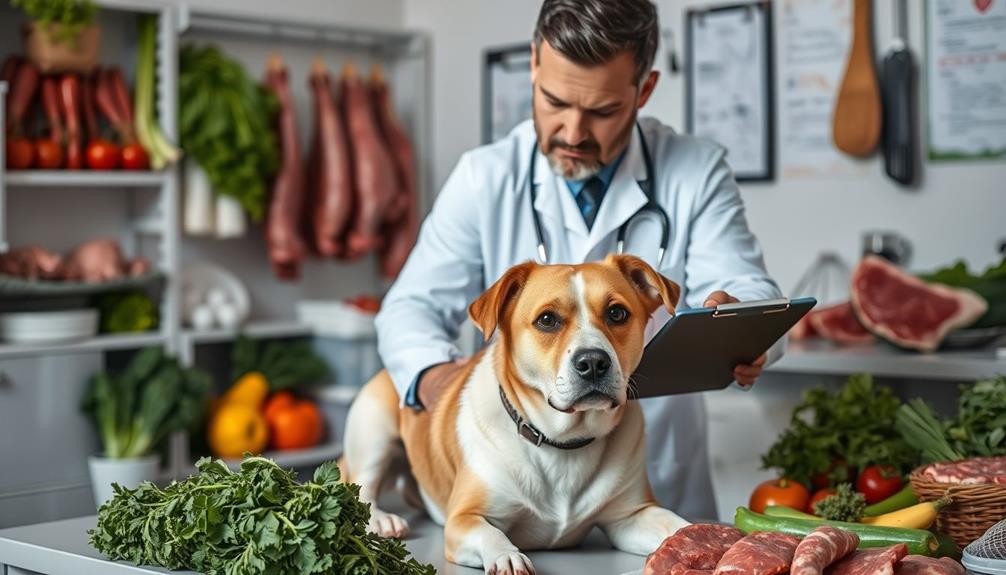
Veterinary insights play an essential role in the successful change to a raw food diet for dogs. When you're considering this alteration, it's important to understand that abrupt changes can lead to digestive upset, with diarrhea being a common response.
To minimize the risk of gastrointestinal issues, veterinarians recommend gradually introducing raw food over a 7-10 day period. This slow adjustment allows your dog's digestive system to adjust effectively.
Regular veterinary check-ups are significant during this time. They help monitor for any persistent diarrhea, which could indicate underlying health issues that need addressing. Your vet can also tailor dietary plans to meet your dog's specific health needs, ensuring the diet supports overall well-being.
Consulting with a veterinarian provides essential guidance on safe raw feeding practices. They can help you identify potential food allergies that may lead to gastrointestinal upset, allowing you to make informed decisions.
Community Resources and Support

Community support plays an essential role in steering the change to a raw food diet for your dog. Engaging with local resources can enhance your understanding of the health benefits of a natural diet and help you navigate any concerns you may have.
Here are some community resources you can tap into:
- Community Events: Attend gatherings like Doggy High Tea or Paws on the Promenade, where you can connect with other dog owners and learn about pet nutrition.
- Local Pet Stores: These stores often provide expert advice on dietary concerns, offering products like dewormers to guarantee your dog stays healthy.
- Online Platforms: Join forums and social media groups dedicated to raw diets, where you can share experiences and gather insights from fellow pet owners.
- Veterinary Associations: Refer to guidelines and position statements from veterinary organizations that offer evidence-based information on raw diets.
Participating in these initiatives not only helps you make informed choices but also fosters a sense of responsibility among pet owners, guaranteeing your dog enjoys a balanced and nutritious diet.
Frequently Asked Questions
Why Does My Dog Have Diarrhea After Eating Raw Food?
If your dog has diarrhea after eating raw food, it might be adapting to new proteins or fats. Abrupt diet changes can upset their stomach, so consider shifting gradually to help ease the digestive process.
How Do I Know if My Dogs Has Gotten Sick off Raw Food?
You'll know your dog's sick from raw food if you notice diarrhea, vomiting, or unusual behavior within hours of feeding. Keep an eye out for lethargy, appetite loss, or blood in stool, and consult your vet.
What Raw Food Is Good for Dogs With Diarrhea?
When your dog has diarrhea, consider introducing easily digestible raw foods like lean turkey or fish. Start slowly, mixing small amounts with their regular diet to help stabilize their stomach and improve digestion.
How Do You Harden a Dog's Stool on a Raw Diet?
About 30% of dogs experience digestive upset during diet changes. To harden your dog's stool on a raw diet, gradually mix in fiber-rich foods, adjust fat content, and consider adding probiotics for gut support.
Conclusion
In the journey of feeding your dog a raw food diet, it's essential to stay informed and observant. Just like you might notice a friend's stomach upset after trying a new dish, your dog could react similarly. By understanding their needs, shifting carefully, and monitoring their reactions, you can help prevent digestive issues like diarrhea. With the right approach and the support of your vet, you can guarantee your furry friend thrives on their new diet.

